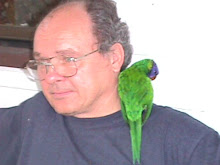Matters rootle along at a steady pace down Allen Road. There is always the odd excitement, such as a Pacific Baza Aviceda subcristata suddenly sweeping into view from over the tin shed. Its presence had, of course, long since been advertised by the raucous din of the Noisy Miners Manorina melanocephala. However, in general, avian life follows a fairly set routine. One day can be very much like another.
Not that Fay and I are complaining. It’s the bread-and-butter birds of your local patch that set the overall ambience.
We may object to the Torresian Crows Corvus orru which continually steals our chicken and duck eggs but where would the local ecology be without their presence? As scavengers they are second to none among the birds.
The Apostlebirds Struthidea cinerea may be the bullies of the Verandah Feeder, often harassing the attractive Australian King-Parrots Alisterus scapularis from off the terracotta plant saucer itself but their communal co-operation remains a spectacle par excellence. The vocal gymnastics of the Australian Magpies Cracticus tibicen continues to bring auditory pleasure to our ears, just as does the amazing sight of two male magpies sharing a feeding spot together.
Other “regulars” present themselves each and every day. A pair of Grey Butcherbirds Cracticus torquatus has successfully trained Fay and I to provide them with slivers of cheese when they alight on the verandah rail. The Grey-crowned Babblers Pomatostomus temporalis have learnt how to extract discarded sunflower seeds from between the cracks in the verandah decking. The more aggressive of the Rainbow Lorikeets Trichoglossus haematodus appears to have either taken anger-management consultation, moved out of the immediate area or perhaps has even passed on to wherever it is deceased birds go.
No, oddities and rarities are all very well but the non-appearance of our everyday species would be of real concern. We still vividly recall the shock of learning that the humble Tree Sparrow Passer montanus population in the United Kingdom has plummeted; we’ve heard rumours that a similar fate is befalling the even humbler House Sparrow Passer domesticus. Worse yet, consider the Passenger Pigeon Ectopistes migratorius; in its millions one day, extinct the next.
Yet, in spite of all the above, the unexpected appearance of the Red-winged Parrot Aprosmictus erythropterus, quietly perched in a small Wren Garden sapling, next to our angophora tree, was more than mildly exciting. It was only the 17th sighting of this bird on our property since its first appearance back at the end of August 2008.
Its timing was awkward. Fay and I were sitting on the east verandah, sipping coffee, when we suddenly spotted the obvious flash of red wing partly hidden behind foliage. It didn’t need past experience to warn us that Red-wings tend to be skittish, will fly at the least provocation. Fortunately both binoculars and cameras were to hand. I carefully picked up one of the latter, switched on and slowly dropped to my knees on the verandah decking. The southside balustrades would act as partial cover.
On reaching the southeast corner of the verandah I eased myself up, for all the world trying to look a mere extension of the corner post. I fired in the first shot. The Red-wing twitched the photograph was rubbish. I tried a second shot, no mean feat when you’re trying to be a wooden post keeping movement to a minimum. The Red-wing shifted uneasily; the photograph was only marginally better.
I got in a third shot; the bird was distinctly jittery by now.
The second shot, a “D”.
The third shot for which I award myself a “C”, more for the effort than the photographic niceties.
I backed off. It didn’t need a PhD to reason that my next shot could be my last shot and for a long moment I hesitated. Did I need another shot that would surely drive the bird away? Would it be more ethical to abandon photography to allow the bird space?
I needed another shot but a Pied Currawong Strepera graculina suddenly alighting atop the same sapling settled the issue; the Red-wing flew off to the east and I was left with three rather poor shots, ranging from a barely passable “C” to a disappointing “D-minus“.
The pair of Magpie-larks Grallina cyanoleuca reminded me of what really matters along Allen Road.


No comments:
Post a Comment